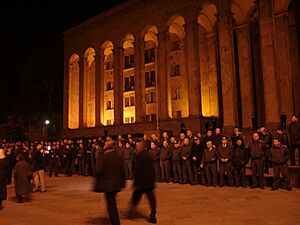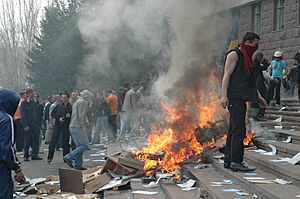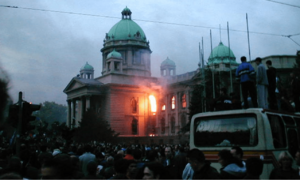Colour revolution facts for kids
Quick facts for kids Colour revolutions |
|
|---|---|

Map of the colour revolutions
Revolution successful Revolution unsuccessful Protests' status as part of the colour revolutions disputed |
|
| Location | |
| Caused by |
|
| Methods |
|
| Resulted in |
|
The colour revolutions (sometimes coloured revolutions) were a series of often non-violent protests and accompanying (attempted or successful) changes of government and society that took place in post-Soviet states (particularly Armenia, Georgia, Ukraine, and Kyrgyzstan) and the Federal Republic of Yugoslavia during the early 21st century. The aim of the colour revolutions was to establish Western-style liberal democracies. They were primarily triggered by election results widely viewed as falsified. The colour revolutions were marked by the usage of the internet as a method of communication, as well as a strong role of non-governmental organizations in the protests.
Some of these movements have been successful in their goal of removing the government, such as the Federal Republic of Yugoslavia's Bulldozer Revolution (2000), Georgia's Rose Revolution (2003), Ukraine's Orange Revolution (2004), Kyrgyzstan's Tulip Revolution (2005) and Armenia's Velvet Revolution (2018). They have been described by political scientists Valerie Jane Bunce and Seva Gunitsky as a "wave of democracy," between the Revolutions of 1989 and the 2010–2012 Arab Spring.
Contents
Background
Student movements
The first of these was Otpor! ('Resistance!') in the Federal Republic of Yugoslavia, founded at Belgrade University in October 1998 and began protesting against Miloševic during the Kosovo War. Most of them were already veterans of anti-Milošević demonstrations such as the 1996–97 protests and the 9 March 1991 protest. Many of its members were arrested or beaten by the police. Despite this, during the presidential campaign in September 2000, Otpor! launched its Gotov je (He's finished) campaign that galvanized Serbian discontent with Milošević and resulted in his defeat.
Members of Otpor! have inspired and trained members of related student movements, including Kmara in Georgia, PORA in Ukraine, Zubr in Belarus, and MJAFT! in Albania. These groups have been explicit and scrupulous in their non-violent resistance, as advocated and explained in Gene Sharp's writings.
Successful protests
Serbia
In the 2000 Yugoslavian general election, activists that opposed the government of Slobodan Milošević created a unified opposition and engaged in civic mobilization through get-out-the-vote campaigns. This approach had been used in other parliamentary elections in Bulgaria (1997), Slovakia (1998), and Croatia (2000). However, election results were contested with the Federal Election Commission announcing that opposition candidate Vojislav Koštunica had not received the absolute majority necessary to avoid a runoff election despite some political sources believing he had earned nearly 55% of the vote. Discrepancies in vote totals and the incineration of election documents by authorities lead the opposition alliance to accuse the government of electoral fraud.
Protests erupted in Belgrade, culminating in the overthrow of Slobodan Milošević. The demonstrations were supported by the youth movement Otpor!, some of whose members were later involved in revolutions in other countries. These demonstrations are usually considered to be the first example of the peaceful revolutions that followed in other former Soviet states. Despite the nationwide protesters not adopting a colour or a specific symbol, the slogan "Gotov je" (Serbian Cyrillic: Готов је, lit. 'He is finished') become a defining symbol in retrospect, celebrating the success of the protests. The protests have come to be known as the Bulldozer Revolution due to the use of a wheel loader that protesters drove into the building used by Radio Television of Serbia, which was the main broadcast arm of Milošević's government.
Georgia

The Rose Revolution in Georgia, following the disputed 2003 election, led to the overthrow of Eduard Shevardnadze and replacing him with Mikhail Saakashvili after new elections were held in March 2004.
Adjara
Following the Rose Revolution, the 2004 Adjara crisis (sometimes called "Second Rose Revolution" or "Mini-Rose Revolution") led to the exit of Chairman of the Government of Georgia's Adjaran Autonomous Republic Aslan Abashidze from office.
Ukraine
The Orange Revolution in Ukraine followed the disputed second round of the 2004 Ukrainian presidential election, leading to the annulment of the result and the repeat of the round—Leader of the Opposition Viktor Yushchenko was declared President, defeating Viktor Yanukovych.
Kyrgyzstan (2005)
The Tulip Revolution (sometimes called the "Pink Revolution") in Kyrgyzstan was more violent than its predecessors and followed the disputed 2005 Kyrgyz parliamentary election. At the same time, it was more fragmented than previous "colour revolutions". The protesters in different areas adopted the colours pink and yellow for their protests.
Moldova

There was civil unrest, described by some as a revolution, all over Moldova following the 2009 Parliamentary election, owing to the opposition's assertion that the communists had fixed the election. In the lead-up to the election, there had been an overwhelming pro-communist bias in the media, and the composition of electoral registers was subject to scrutiny. European electoral observers had concluded that there was "undue administrative influence" in the election. There had also been anger at president Vladimir Voronin, who had agreed to step down as term limits in the constitution required but who then said he would retain a key role in politics, leading to fears that there would be no real change in power. The views and actions of the Soviet-trained and Russian-speaking political elite contrasted with the majority of the country's population as a whole, which favoured a more pro-European direction. Also key to the context was the question of relations with Romania, which Moldova had been separated from after Russian occupation under the Nazi-Soviet Pact of 1939. Demands for closer relations with Romania had increased due to Romania's EU membership contrasting with economic stagnation and failure in Moldova. Under the communists, Moldova had the status of the poorest country in Europe, and international agencies had criticised the government for failing to address corruption and for limiting press freedoms.
The government attempted to discredit the protests by claiming foreign involvement of Romania, but little evidence existed which suggested this was the case. Between 10,000 and 15,000 people joined protests on 6 and 7 April 2009 in the capital city of Chisinau. Some of the chants protesters were heard to say were "We want Europe", "We are Romanians" and "Down with Communism". With social media playing a role in the organisation of the protests, the internet was cut off in the capital by the government. President Voronin's reaction to the protests were subject to criticism; he utilised the secret police, oversaw mass arrests, sealed the country's borders and censored media, leading to comparisons to Stalinist methods of communist repression.
One of the key demands of the protests was achieved when a recount of votes in the election was accepted and ordered by president Voronin. Then, in July 2009 a new election was held in which opposition parties won a slight majority of the vote, which was seen as a decisive success for the four pro-Western, pro-European parties. One of the factors believed to have led to the opposition victory was the anger at the way the communist government had handled the April protests. The deputy leader of the opposition Liberal Party stated that "Democracy has won". The opposition alliance (the Alliance for European Integration) created a governing coalition that pushed the Communist party into opposition.
Armenia
In 2018, a peaceful revolution was led by a member of parliament, Nikol Pashinyan in opposition to the nomination of Serzh Sargsyan as Prime Minister of Armenia, who had previously served as both President of Armenia and prime minister, eliminating term limits that would have otherwise prevented his 2018 nomination. Concerned that Sargsyan's third consecutive term as the most powerful politician in the government of Armenia gave him too much political influence, protests occurred throughout the country, particularly in Yerevan. However, demonstrations in solidarity with the protesters also occurred in other countries where the Armenian diaspora live. During the protests, Pashinyan was arrested and detained on 22 April, but he was released the following day. Sargsyan stepped down from the position of Prime Minister, and his Republican Party decided not to put forward a candidate. An interim Prime Minister was selected from Sargsyan's party until elections were held, and protests continued for over one month. Crowd sizes in Yerevan consisted of 115,000 to 250,000 people throughout the revolution, and hundreds of protesters were arrested. Pashinyan referred to the event as a Velvet Revolution. A vote was held in parliament, and Pashinyan became the Prime Minister of Armenia.
Pattern of revolution
Michael McFaul identified seven stages of successful political revolutions common in colour revolutions:
- A semi-autocratic rather than fully autocratic regime
- An unpopular incumbent
- A united and organized opposition
- An ability to quickly drive home the point that voting results were falsified
- Enough independent media to inform citizens about the falsified vote
- A political opposition capable of mobilizing tens of thousands or more demonstrators to protest electoral fraud
- Divisions among the regime's coercive forces
See also
- People power
- Civil resistance
- Revolutions of 1989
- Arab Spring
- Spring Revolutions (disambiguation)
- Proriv, dissolved party in Transnistria which was inspired by Kmara and Otpor!
- United States involvement in regime change
- Post-Soviet conflicts



